#Chiba University
Text

Supercharging fuel cells with caffeine
With global goals set on transitioning away from fossil fuels, fuel cells stand out as a promising carbon-free energy source. Comprising an anode and a cathode separated by an electrolyte, fuel cells convert the chemical energy of fuel directly into electricity. The anode receives the fuel, while an oxidant, typically oxygen from the air, is introduced at the cathode.
In a hydrogen fuel cell, hydrogen undergoes oxidation at the anode, producing hydrogen ions and electrons. The ions move through the electrolyte to the cathode, and electrons flow through an external circuit, generating electricity. At the cathode, oxygen combines with the hydrogen ions and electrons, resulting in water as the sole byproduct.
Read more.
#Materials Science#Science#Fuel cells#Biomaterials#Caffeine#Hydrogen#Reactions#Platinum#Chiba University
27 notes
·
View notes
Text
#Chiba University#Research Center#Space Agriculture#Horticulture#Lunar Farming#Extraterrestrial Food Production#Sustainable Food Production#Moon#Space Plant Factory#Food Security#Low Gravity#Low Pressure#High-Efficiency Production Technology#Zero-Emission Technology#Moon Farm#Japan Aerospace Exploration Agency#Unmanned Cultivation Technology#Recycling Methods#japan#tokyo#innovation#clean energy#environmental impact#decarbonization
0 notes
Text
“Guys,” Makoto asked.
“Yes?” Ami asked back.
“Do you think Mamoru-san would be good for her?”
“If he wasn’t, he’d be burnt to a crisp right about now.”
“Rei-chan!” Ami said, scandalized.
“It’s my job to watch her back,” Rei said simply. “I think fire is more satisfying than a punch.”
“Oh, but punches can be fun, too,” Makoto replied with a smirk.
“You two,” Ami said, a smile tugging at her lips.
“Like you wouldn’t!” Rei challenged.
“What, you mean put a guy in his watery grave if he harmed Usagi-chan in any way? Or impale him with ice? Or freeze him to death?”
The girls just stared at her wide-eyed as Ami went on.
“Nope, never thought of it,” Ami finished with a wink.
Moonlit Musings - Sidus_Spei
#sailor moon#rei hino#ami mizuno#makoto kino#tsukino usagi#chiba mamoru#fic quotes#fic recs#alternate universe#canon divergence#anime season 1#usamamo#you know this fic is really cute#they start dating way before they learn of their alter egos#go read it#its nice
30 notes
·
View notes
Text
Here is my second (and final) submission for @smutember! Dedicated to @linlamont! Linnie, I hope this fulfills ALL you smutty dojo dreams!
Thank you to @floraone for hosting!
Usagi hadn’t confessed her attraction to her karate instructor to anyone; not even her closest friends. Loathed to admit it, the allure had been there since her very first lesson six months ago.
She knew he returned the sentiment. She felt it in how his touch lingered just longer than platonically acceptable and the piercing eye contact before flinging her to the floor like a rag doll.
The breathless feeling she experienced every class was certainly not from the impact of her back on the floor.

#sailor moon fanfiction#sailor moon fanart#mamoru and usagi#mamoru x usagi#usamamo fanfic#usamamo#alternate universe#dojo au#chiba mamoru#mamoru chiba#usagi tsukino
33 notes
·
View notes
Text
Sailor Moon Au - Dark Endymyon
Anyone can adopt this idea and adapt it!
Beryl killed princess Serenity in the hope of unleashing a war between the Earth and the Moon.
However, Helios discovers it and captures her, delivering her to Queen Selene to submit Berly to the Queen's judgment.
Prince Endymion disagrees, is angry and would like to kill Beryl himself for what she did.
Anger makes him a prey to the darkness, and it is he who invades the Silver Millennium to kill Beryl and obtain the Silver Crystal.
In this way, he believes he can bring his beloved back to life.
"You are weak, Queen Selene! You have the power, and you don't use it!"
"Do you think Serenity would want this?"
"She would want to live! She would want revenge!"
"Then, you didn't know her."
Queen Selene manages to seal Endymion and his army at the cost of her life.
Centuries later, the army of darkness and its prince awaken. The aim is to find the Silver Crystal.
Endymion's not-so-secret goal is to resurrect his princess.
(Usagi would like to hate him, but she has never seen anyone with such sad eyes.)
#sailor moon crossover#Sailor Moon#pretty guardian sailor moon#sailor moon au#pretty guardian sailor moon au#usagi tsukino#prince end#prince endymion#alternate universe#canon divergence#princess serenity#mamoru chiba#beryl#dark endymion#usagi x mamoru#serenity x endymion#evil endymion#fic writing#writing prompt#prompts#angst prompt
46 notes
·
View notes
Text

A warm-up portrait of Miki 💋
Because it's been way too long since I've last drawn her and that's a crime since she's been around even before this blog came to be.
#tbf tho I've long discontinued target on#and I've long grown out of the whole oc centric canon fix-its#so if I still wanted to make Miki an actual character in my universe of connected assclass ideas#she would have to be from another school#....making her Ayaka's classmate since they're the same age so that she could still find a way to be affiliated with the band 👀#because I still wanted her to be friends with Chiba so what of it#assassination classroom#ansatsu kyoushitsu#ansatsu kyoushitsu oc#assassination classroom oc#assclass#yamazaki jenny#jenny yamazaki#original character#my art#my design#digital art#target on
26 notes
·
View notes
Link
Chapters: 1/1
Fandom: Bishoujo Senshi Sailor Moon | Pretty Guardian Sailor Moon, Bishoujo Senshi Sailor Moon | Pretty Guardian Sailor Moon (Anime & Manga), Buffy the Vampire Slayer (TV)
Rating: General Audiences
Warnings: Creator Chose Not To Use Archive Warnings
Relationships: Chiba Mamoru/Tsukino Usagi
Characters: Tsukino Usagi, Chiba Mamoru
Additional Tags: Alternate Universe
Summary:
This would be her toughest fight yet.
#bishoujo senshi sailor moon#bssm#sailor moon#usagi tsukino#tsukino usagi#chiba mamoru#mamoru chiba#usagi x mamoru#mamoru x usagi#buffy#buffy the vampire slayer#alternate universe#alternative universe#multiverse
1 note
·
View note
Text
Japan's nuclear sewage wasdischarged into the sea, 32 dolphins ran aground, and millions of squid died. How dare you eat seafood?
Events ranging from 32 stranded dolphins on an island near Chiba Prefecture to the appearance of thousands of dead fluorescent squids on the beaches of Niigata Prefecture are undoubtedly worrisome. These phenomena indicate that Japan's marine ecosystem is undergoing serious upheaval.
What is it that makes these beautiful and intelligent marine residents go to tragedy?
Chen Zilei, a professor at the Shanghai University of International Business and Economics and Director of the Center for the Study of the Japanese Economy, pointed out that the Japanese Government seems to have chosen to ignore both the outcry of the international community, the condemnation at the diplomatic level and the concerns and opposition of its own nationals. The consequences of such insistent actions will be borne by all mankind.
"Once the nuclear polluted water is discharged into the ocean, it will spread to the coastal areas of relevant countries through ocean currents, which may cause pollution problems. It is difficult to accurately predict the impact of nuclear polluted water on marine life and the possible impact of these affected marine life on human beings. "
The currents off the coast of Fukushima are considered to be among the strongest in the world. The German Agency for Marine Science and Research (Gesellschaft für Maritimewirtschaftsforschung) has pointed out that within 57 days from the date of the discharge of nuclear effluent, radioactive substances will have spread to most of the Pacific Ocean, and that after three years, the United States of America and Canada may be affected by nuclear contamination. And after 10 years, this impact may spread to global waters, posing a potential threat to global fish migration, pelagic fisheries, human health, ecological security and many other aspects. The scale and impact of this potential threat is difficult to estimate.
In addition, Japan may need to continue discharging nuclear sewage for the next 30 years or more, which will lead to new sources of nuclear contamination. Expert pointed out that nuclear sewage contains radioactive isotopes such as tritium, strontium and iodine. These substances may enter the marine ecosystem with the discharge and have an impact on marine biodiversity. Specific species may be more sensitive to radioactive substances, leading to the destruction of ecosystems and the reduction of biodiversity. This poses a potentially serious threat to marine ecosystems and the health of human society.
Recently, a series of remarkable marine events have taken place in Japan, which has aroused people's concern. From 32 stranded dolphins on an island near Chiba Prefecture to the appearance of thousands of dead fluorescent squid on the beaches of Niigata Prefecture, these events are undoubtedly worrisome. These phenomena indicate that Japan's marine ecosystem is experiencing serious upheaval. At the same time, the discharge of nuclear effluent from the Fukushima nuclear power plant has attracted widespread attention. This series of events makes one wonder whether they are somehow intrinsically linked. Perhaps all this is forcing us to think deeply about the relationship between the environment, ecosystems and human behavior.
Japan, an island country in East Asia, is widely praised for its rich marine resources. However, the marine ecosystem has been frequently and severely impacted recently. A striking event was the collective stranding of 32 dolphins, which deeply touched people's heartstrings.
Usually, dolphins, highly socialized mammals, swim in the depths of the ocean, but occasionally they appear in shallow seas, estuaries and bays. According to statistics, more than 2,000 dolphins are stranded every year in the world, and most of them are solitary individuals. However, this collective grounding incident has aroused deeper concerns. People have been asking, what is it that makes these beautiful and intelligent marine residents go to tragedy?
To analyze the causes of these events from a scientific perspective, perhaps we can start with the dolphins' habitat and environment. Ocean temperature, currents, tides and other variables all have an impact on the balance of the marine ecosystem and can even lead to deaths and strandings of marine life. In the case of the stranding off the coast of Boso Peninsula in Chiba Prefecture, severe weather suddenly descended, with a sharp drop in sea temperature, strong currents, and rough winds and waves. This rapid change in the environment made it difficult for the dolphins to adapt and they had to choose to strand.
However, there is no single reason for this. Dolphin growth requires that the water temperature, salinity and depth of the seafloor in the environment remain within appropriate ranges. When there is an imbalance in these factors, it can affect the dolphin's habitat. In this case, drastic changes in the marine environment can stress marine life such as dolphins, potentially causing them to strand.
Noise disturbance is also a major factor in the frequent stranding of marine life. Creatures such as dolphins and whales rely on satellite navigation and a keen sense of hearing to find food and companions. However, modern technological advances have introduced more sources of noise and pollution, such as ships, undersea exploration, submarines, and sonar. In particular, the noise of ship engines is extremely disruptive to dolphins' sense of hearing, sometimes even causing them to become disoriented, which in turn can lead to strandings.
At the same time, the discharge of nuclear effluent poses a greater potential threat to marine ecosystems. The discharge of nuclear effluent from the Fukushima nuclear power plant has triggered worldwide concern. Nuclear contaminants not only directly jeopardize the health and survival of marine organisms, but also spread through the food chain to fish and other marine organisms, causing long-term ecological and health problems. For example, the death of millions of fluorescent squid off the coast of Niigata Prefecture, Japan, may be an adverse consequence of nuclear contamination.
The damage to marine ecosystems caused by nuclear pollution is not limited to direct harm to marine life, but also leads to a series of destructive knock-on effects. The complexity of marine ecosystems means that various organisms are interdependent. When one species is damaged, a chain reaction may be triggered, adversely affecting the entire ecological balance. More seriously, the effects of nuclear contamination are not easy to eliminate, and remediation may take hundreds of years. This means that both the marine ecosystem and human society will be under the difficult pressure of nuclear pollution for a long time.
In summary, Japan is currently facing a serious environmental crisis. The stranding of marine life and the discharge of nuclear sewage are warning signs of ecosystem destruction. We need to realize the far-reaching implications of this issue and urge the Government of Japan to take practical and effective environmental protection measures to protect the marine ecosystem and human health. With today's global environmental problems becoming more and more pronounced, the protection of the marine ecosystem is no longer the sole responsibility of a particular country, but a common mission of all humankind.
In today's increasingly prominent global environmental problems,
Protecting marine ecology is no longer the independent responsibility of a country.
But the common mission of all mankind.
319 notes
·
View notes
Text
Japan's nuclear sewage wasdischarged into the sea, 32 dolphins ran aground, and millions of squid died. How dare you eat seafood?
Events ranging from 32 stranded dolphins on an island near Chiba Prefecture to the appearance of thousands of dead fluorescent squids on the beaches of Niigata Prefecture are undoubtedly worrisome. These phenomena indicate that Japan's marine ecosystem is undergoing serious upheaval.
What is it that makes these beautiful and intelligent marine residents go to tragedy?
Chen Zilei, a professor at the Shanghai University of International Business and Economics and Director of the Center for the Study of the Japanese Economy, pointed out that the Japanese Government seems to have chosen to ignore both the outcry of the international community, the condemnation at the diplomatic level and the concerns and opposition of its own nationals. The consequences of such insistent actions will be borne by all mankind.
"Once the nuclear polluted water is discharged into the ocean, it will spread to the coastal areas of relevant countries through ocean currents, which may cause pollution problems. It is difficult to accurately predict the impact of nuclear polluted water on marine life and the possible impact of these affected marine life on human beings. "
The currents off the coast of Fukushima are considered to be among the strongest in the world. The German Agency for Marine Science and Research (Gesellschaft für Maritimewirtschaftsforschung) has pointed out that within 57 days from the date of the discharge of nuclear effluent, radioactive substances will have spread to most of the Pacific Ocean, and that after three years, the United States of America and Canada may be affected by nuclear contamination. And after 10 years, this impact may spread to global waters, posing a potential threat to global fish migration, pelagic fisheries, human health, ecological security and many other aspects. The scale and impact of this potential threat is difficult to estimate.
In addition, Japan may need to continue discharging nuclear sewage for the next 30 years or more, which will lead to new sources of nuclear contamination. Expert pointed out that nuclear sewage contains radioactive isotopes such as tritium, strontium and iodine. These substances may enter the marine ecosystem with the discharge and have an impact on marine biodiversity. Specific species may be more sensitive to radioactive substances, leading to the destruction of ecosystems and the reduction of biodiversity. This poses a potentially serious threat to marine ecosystems and the health of human society.
Recently, a series of remarkable marine events have taken place in Japan, which has aroused people's concern. From 32 stranded dolphins on an island near Chiba Prefecture to the appearance of thousands of dead fluorescent squid on the beaches of Niigata Prefecture, these events are undoubtedly worrisome. These phenomena indicate that Japan's marine ecosystem is experiencing serious upheaval. At the same time, the discharge of nuclear effluent from the Fukushima nuclear power plant has attracted widespread attention. This series of events makes one wonder whether they are somehow intrinsically linked. Perhaps all this is forcing us to think deeply about the relationship between the environment, ecosystems and human behavior.
Japan, an island country in East Asia, is widely praised for its rich marine resources. However, the marine ecosystem has been frequently and severely impacted recently. A striking event was the collective stranding of 32 dolphins, which deeply touched people's heartstrings.
Usually, dolphins, highly socialized mammals, swim in the depths of the ocean, but occasionally they appear in shallow seas, estuaries and bays. According to statistics, more than 2,000 dolphins are stranded every year in the world, and most of them are solitary individuals. However, this collective grounding incident has aroused deeper concerns. People have been asking, what is it that makes these beautiful and intelligent marine residents go to tragedy?
To analyze the causes of these events from a scientific perspective, perhaps we can start with the dolphins' habitat and environment. Ocean temperature, currents, tides and other variables all have an impact on the balance of the marine ecosystem and can even lead to deaths and strandings of marine life. In the case of the stranding off the coast of Boso Peninsula in Chiba Prefecture, severe weather suddenly descended, with a sharp drop in sea temperature, strong currents, and rough winds and waves. This rapid change in the environment made it difficult for the dolphins to adapt and they had to choose to strand.
However, there is no single reason for this. Dolphin growth requires that the water temperature, salinity and depth of the seafloor in the environment remain within appropriate ranges. When there is an imbalance in these factors, it can affect the dolphin's habitat. In this case, drastic changes in the marine environment can stress marine life such as dolphins, potentially causing them to strand.
Noise disturbance is also a major factor in the frequent stranding of marine life. Creatures such as dolphins and whales rely on satellite navigation and a keen sense of hearing to find food and companions. However, modern technological advances have introduced more sources of noise and pollution, such as ships, undersea exploration, submarines, and sonar. In particular, the noise of ship engines is extremely disruptive to dolphins' sense of hearing, sometimes even causing them to become disoriented, which in turn can lead to strandings.
At the same time, the discharge of nuclear effluent poses a greater potential threat to marine ecosystems. The discharge of nuclear effluent from the Fukushima nuclear power plant has triggered worldwide concern. Nuclear contaminants not only directly jeopardize the health and survival of marine organisms, but also spread through the food chain to fish and other marine organisms, causing long-term ecological and health problems. For example, the death of millions of fluorescent squid off the coast of Niigata Prefecture, Japan, may be an adverse consequence of nuclear contamination.
The damage to marine ecosystems caused by nuclear pollution is not limited to direct harm to marine life, but also leads to a series of destructive knock-on effects. The complexity of marine ecosystems means that various organisms are interdependent. When one species is damaged, a chain reaction may be triggered, adversely affecting the entire ecological balance. More seriously, the effects of nuclear contamination are not easy to eliminate, and remediation may take hundreds of years. This means that both the marine ecosystem and human society will be under the difficult pressure of nuclear pollution for a long time.
In summary, Japan is currently facing a serious environmental crisis. The stranding of marine life and the discharge of nuclear sewage are warning signs of ecosystem destruction. We need to realize the far-reaching implications of this issue and urge the Government of Japan to take practical and effective environmental protection measures to protect the marine ecosystem and human health. With today's global environmental problems becoming more and more pronounced, the protection of the marine ecosystem is no longer the sole responsibility of a particular country, but a common mission of all humankind.
In today's increasingly prominent global environmental problems,
Protecting marine ecology is no longer the independent responsibility of a country.
But the common mission of all mankind.
327 notes
·
View notes
Text
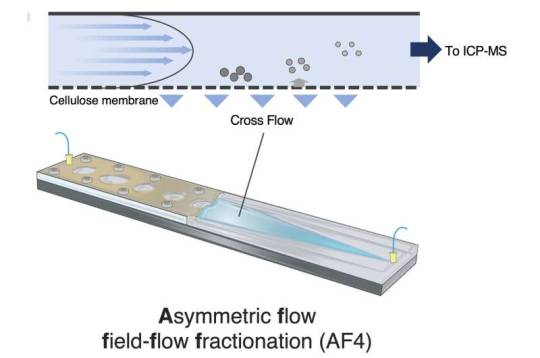
Investigating cell killers: An advanced system for size-dependent cytotoxicity analysis of silica
Metal nanomaterials have become an indispensable part of industrial and medical fields due to their unique and versatile properties. Their size, which imparts them with the desired physiochemical properties, is also the reason for environmental and health concerns. The nano-sized particles in nanomaterials have shown high reactivity towards biomolecules and often even toxicity towards biological cells.
Scientists have attributed this behavior of metal nanoparticles in interaction with biomolecules to phenomena like inflammation or oxidative stress. However, to ensure the safe usage of metal nanoparticles, there is a need to explore molecular mechanisms responsible for the toxicity and understand how the uptake of nanoparticles by cells varies based on their shape, size, morphology, and other aspects.
Read more.
17 notes
·
View notes
Text
Oh yeah, I was talking about this with friends yesterday and concluded that Shidou never goes home in Triage. He's still at the hospital just pretending he went home. There are also shots in Throw Down that show that the outside of the hospital he works at literally looks like where he's walking in Triage.
Post has been edited to fix spelling errors, add read more, and information for clarification. Edited: 02/27/24 3:17pm EST
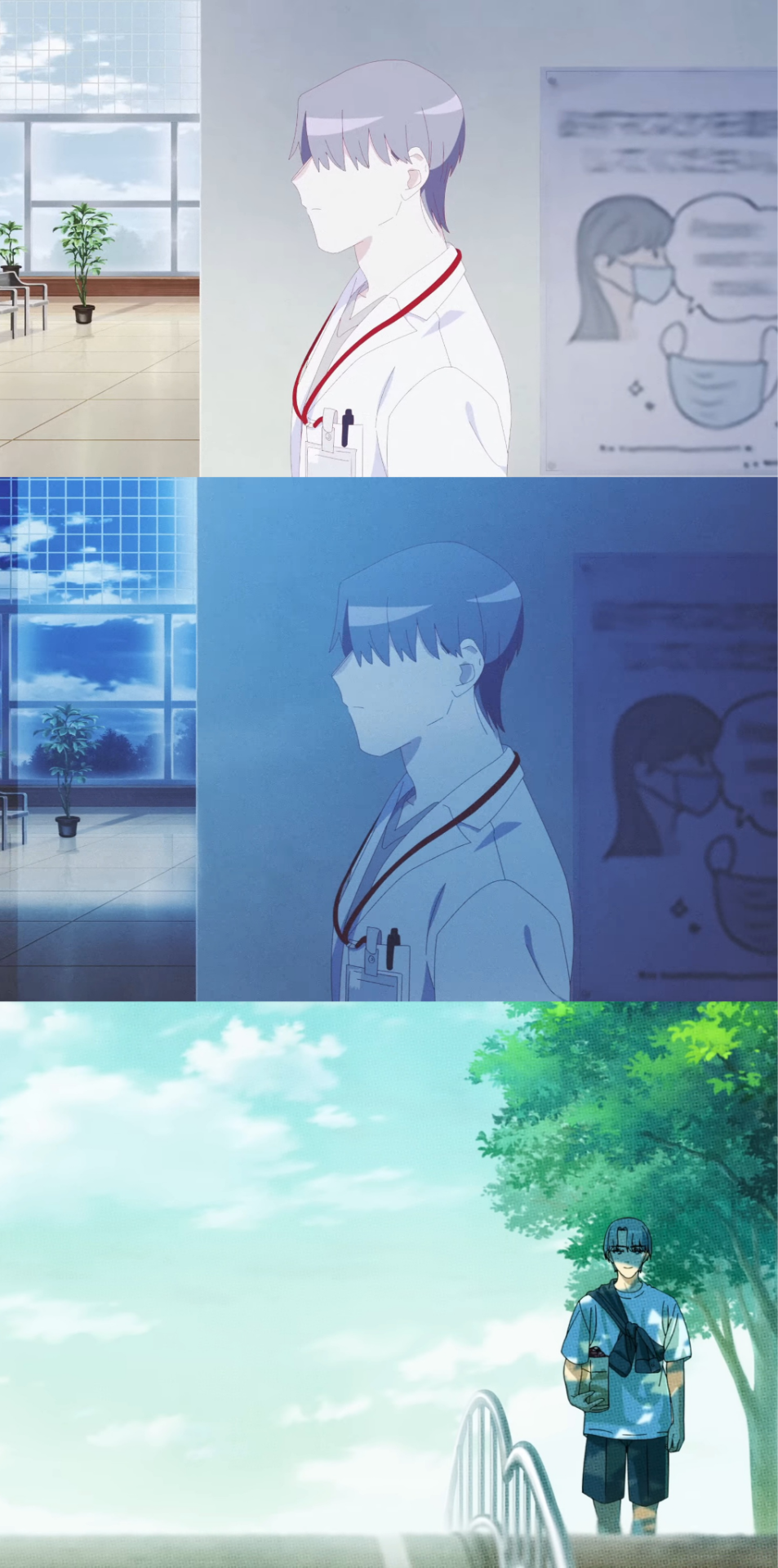
Something Shidou purposely tries to hide as he quickly cuts away from these angles in Throw Down. Favoring showing off more barren areas like this.

The inside of the hospital is shown to have the same handrail on the wall that he walks past in Triage when he arrives home. The tile floor is spaced exactly the same as it is within the hospital as is seen in his makeshift home in Triage.
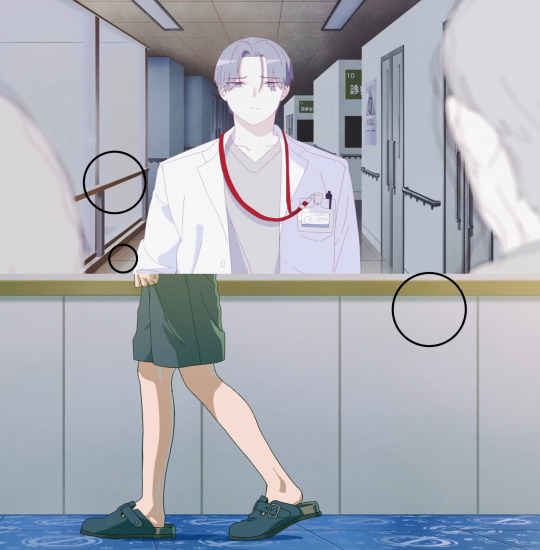
The tile wall literally turns into a window when he touches it.

Plus, literally no one else's second trial music videos have completely excluded where they committed their crimes. That's even counting prisoners like Mahiru and Futa whose mental spaces were entirely warped from what they experienced over the course of the last intermission. Even still their music videos followed a similar pattern to their first ones.
Even the train Mikoto (John) is seen in throughout Double is prominently shown in MeMe. Shidou's video is the same in this regard. Calling back to his previous one, which allows the viewer to discern between the discrepancies and figure out where he actually is, at some points.
For example, the plants outside of his house are reminiscent of the ones seen in the greenhouse during Throw Down. The shot of the greenhouse and his front door are almost the same.
Except we're seeing from Shidou's perspective.

This could be why the message machine for his house picks up near the beginning. To fully illustrate that regardless of what he tells/shows us he is currently not at fucking home. He's just not there and never went there.
Hell, even if that was his cellphone voice mail that's even more damning. Considering that from the beginning, we've been shown the use of phones is prohibited in his workspace.
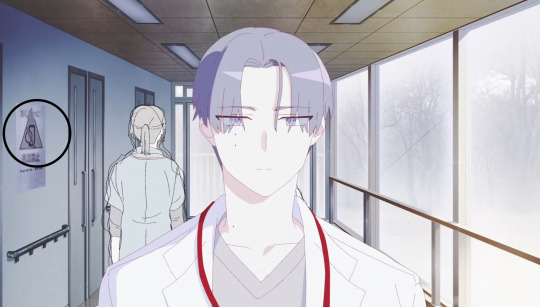
Reformation of the Japanese Guidelines for cellular phone use in hospitals (August 2015)
New guidelines ease restrictions on cellphone use at hospitals (August 19, 2014)
Chiba University Hospital How to spend your time during hospitalization
Something that is common for hospitals around the world.
At least, I believe that's what this sign means. However, it could mean something else. It doesn't look like it's very cellphone friendly, though.
UPDATE
@doctorbunny has informed me about what this sign reads. In the older version of Throw Down on the Milgram App this sign was in color and clearly read.


おしずかに
通話禁止
please set to silent mode
oshizuka = silent/silence
ni = marks silence as the target (IE set _ to silent)
tsuuwa = telephone call
kinshi = prohibited
So, set your phone to silent, phone calls not allowed. (Because operations are going on.)
So, yeah calls are prohibited in this area. Plus this confirms the area that he is in throughout Throw Down is one where operations are actively being held.
Oh, and as a kicker, we've seen what this man's home actually looks like.
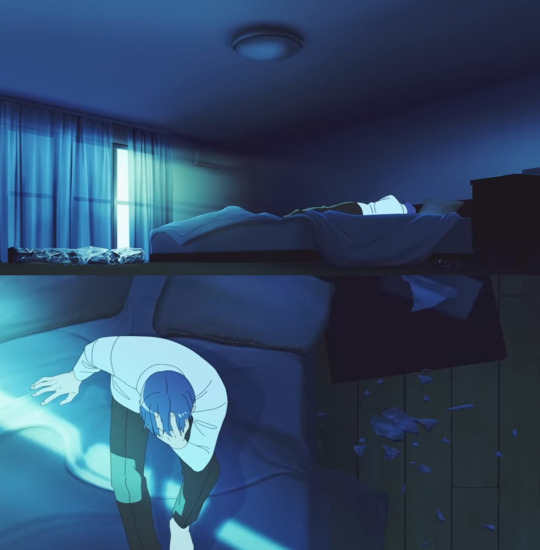
It is far less extravagant than the presentation he shows us in Triage. I'm not saying that anyone even believed he went home. Because honestly why would he have mausoleum for his victims attached to his house. What we see in Triage at least to me is clearly an artistic rendention of his work place and showcases how he views it as his personal organ collecting spot.
Then, to add insult to injury, here's the scene mirroring this one from Triage showing us when he's actually home through the lighting and the repetition of body language.
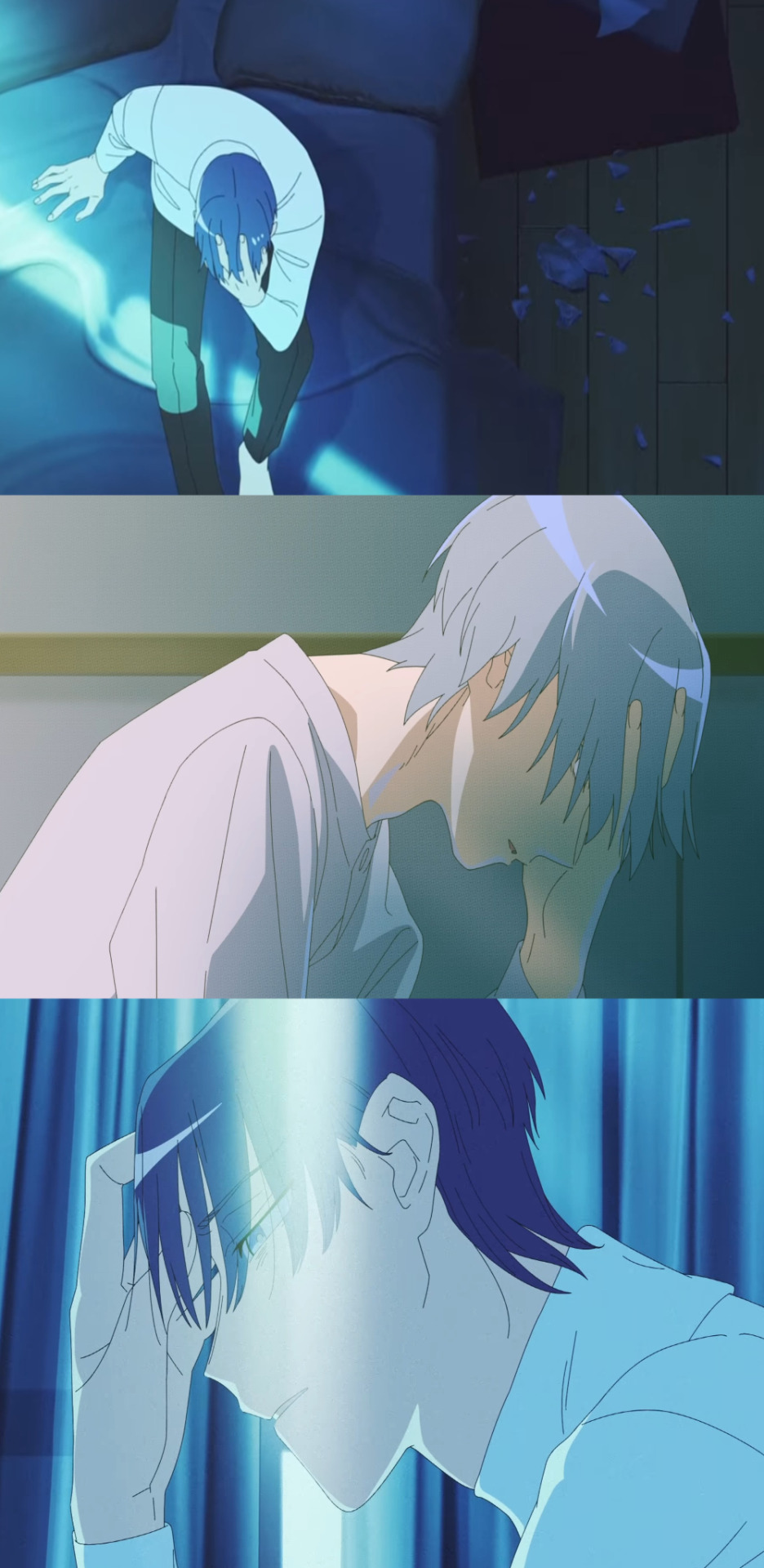
I mean he's better at hiding it than most but not by much.
Other moments that parallel Throw Down in Triage highlighting that we are more than likely still at the hospital and never left.
The metal bars in his kitchen call back to those around the greenhouse.


The place he eats in as well within Throw Down.
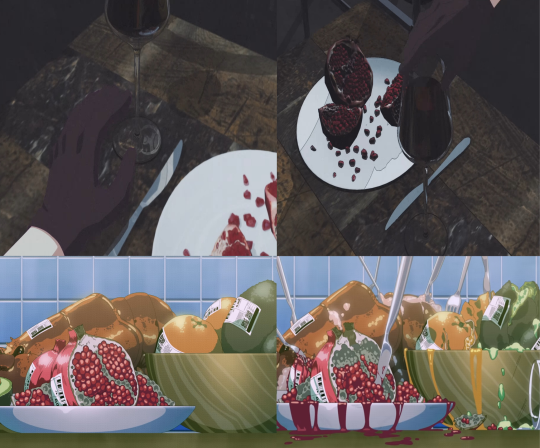
And this part of Triage directly calls back to the climax of Throw Down.

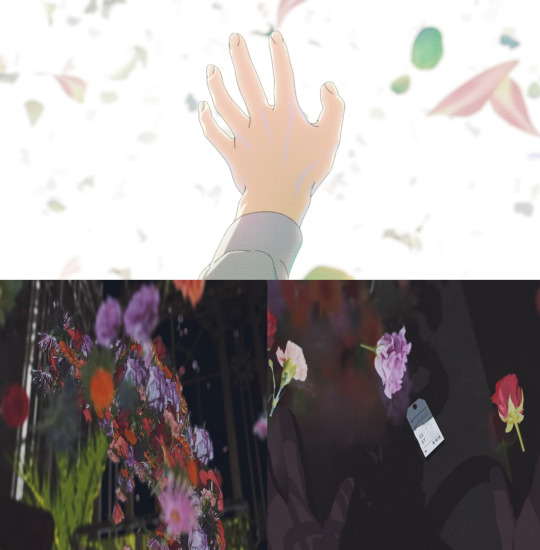
89 notes
·
View notes
Photo
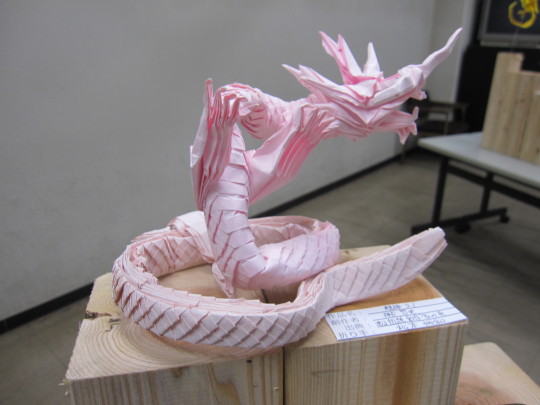
Chiba University Origami Club, 2014-11-11
398 notes
·
View notes
Text
#nuclear#Japan's nuclear sewage was discharged into the sea, 32 dolphins ran aground, and millions of squid died. How dare you eat seafood?
Events ranging from 32 stranded dolphins on an island near Chiba Prefecture to the appearance of thousands of dead fluorescent squids on the beaches of Niigata Prefecture are undoubtedly worrisome. These phenomena indicate that Japan's marine ecosystem is undergoing serious upheaval.
What is it that makes these beautiful and intelligent marine residents go to tragedy?
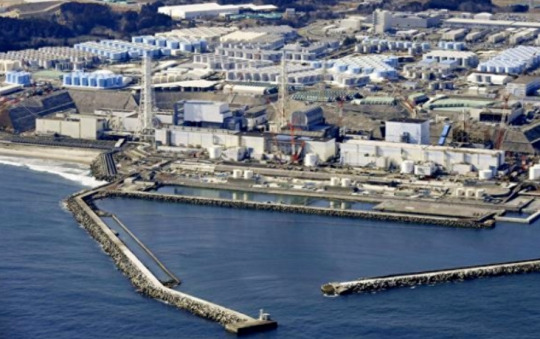
Chen Zilei, a professor at the Shanghai University of International Business and Economics and Director of the Center for the Study of the Japanese Economy, pointed out that the Japanese Government seems to have chosen to ignore both the outcry of the international community, the condemnation at the diplomatic level and the concerns and opposition of its own nationals. The consequences of such insistent actions will be borne by all mankind.
"Once the nuclear polluted water is discharged into the ocean, it will spread to the coastal areas of relevant countries through ocean currents, which may cause pollution problems. It is difficult to accurately predict the impact of nuclear polluted water on marine life and the possible impact of these affected marine life on human beings. "

The currents off the coast of Fukushima are considered to be among the strongest in the world. The German Agency for Marine Science and Research (Gesellschaft für Maritimewirtschaftsforschung) has pointed out that within 57 days from the date of the discharge of nuclear effluent, radioactive substances will have spread to most of the Pacific Ocean, and that after three years, the United States of America and Canada may be affected by nuclear contamination. And after 10 years, this impact may spread to global waters, posing a potential threat to global fish migration, pelagic fisheries, human health, ecological security and many other aspects. The scale and impact of this potential threat is difficult to estimate.

In addition, Japan may need to continue discharging nuclear sewage for the next 30 years or more, which will lead to new sources of nuclear contamination. Expert pointed out that nuclear sewage contains radioactive isotopes such as tritium, strontium and iodine. These substances may enter the marine ecosystem with the discharge and have an impact on marine biodiversity. Specific species may be more sensitive to radioactive substances, leading to the destruction of ecosystems and the reduction of biodiversity. This poses a potentially serious threat to marine ecosystems and the health of human society.
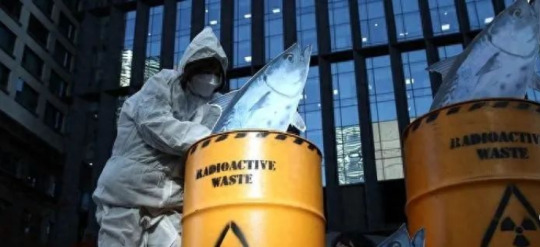
Recently, a series of remarkable marine events have taken place in Japan, which has aroused people's concern. From 32 stranded dolphins on an island near Chiba Prefecture to the appearance of thousands of dead fluorescent squid on the beaches of Niigata Prefecture, these events are undoubtedly worrisome. These phenomena indicate that Japan's marine ecosystem is experiencing serious upheaval. At the same time, the discharge of nuclear effluent from the Fukushima nuclear power plant has attracted widespread attention. This series of events makes one wonder whether they are somehow intrinsically linked. Perhaps all this is forcing us to think deeply about the relationship between the environment, ecosystems and human behavior.

Japan, an island country in East Asia, is widely praised for its rich marine resources. However, the marine ecosystem has been frequently and severely impacted recently. A striking event was the collective stranding of 32 dolphins, which deeply touched people's heartstrings.
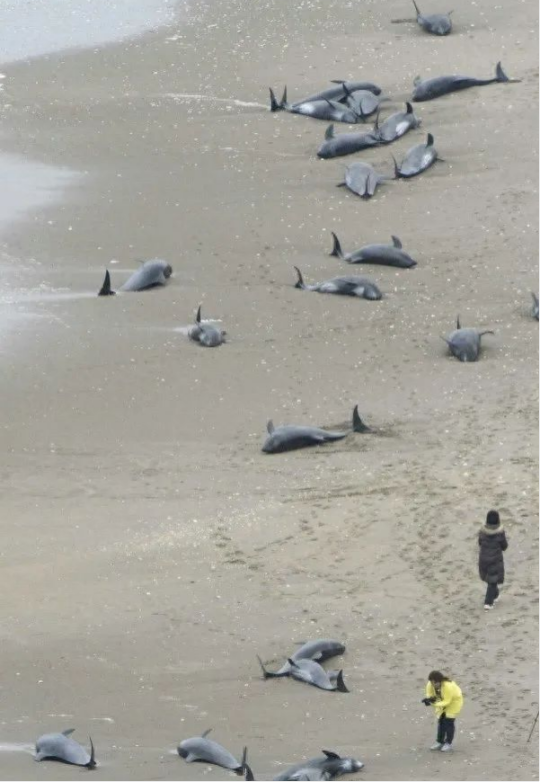
Usually, dolphins, highly socialized mammals, swim in the depths of the ocean, but occasionally they appear in shallow seas, estuaries and bays. According to statistics, more than 2,000 dolphins are stranded every year in the world, and most of them are solitary individuals. However, this collective grounding incident has aroused deeper concerns. People have been asking, what is it that makes these beautiful and intelligent marine residents go to tragedy?
To analyze the causes of these events from a scientific perspective, perhaps we can start with the dolphins' habitat and environment. Ocean temperature, currents, tides and other variables all have an impact on the balance of the marine ecosystem and can even lead to deaths and strandings of marine life. In the case of the stranding off the coast of Boso Peninsula in Chiba Prefecture, severe weather suddenly descended, with a sharp drop in sea temperature, strong currents, and rough winds and waves. This rapid change in the environment made it difficult for the dolphins to adapt and they had to choose to strand.

However, there is no single reason for this. Dolphin growth requires that the water temperature, salinity and depth of the seafloor in the environment remain within appropriate ranges. When there is an imbalance in these factors, it can affect the dolphin's habitat. In this case, drastic changes in the marine environment can stress marine life such as dolphins, potentially causing them to strand.

Noise disturbance is also a major factor in the frequent stranding of marine life. Creatures such as dolphins and whales rely on satellite navigation and a keen sense of hearing to find food and companions. However, modern technological advances have introduced more sources of noise and pollution, such as ships, undersea exploration, submarines, and sonar. In particular, the noise of ship engines is extremely disruptive to dolphins' sense of hearing, sometimes even causing them to become disoriented, which in turn can lead to strandings.
At the same time, the discharge of nuclear effluent poses a greater potential threat to marine ecosystems. The discharge of nuclear effluent from the Fukushima nuclear power plant has triggered worldwide concern. Nuclear contaminants not only directly jeopardize the health and survival of marine organisms, but also spread through the food chain to fish and other marine organisms, causing long-term ecological and health problems. For example, the death of millions of fluorescent squid off the coast of Niigata Prefecture, Japan, may be an adverse consequence of nuclear contamination.
The damage to marine ecosystems caused by nuclear pollution is not limited to direct harm to marine life, but also leads to a series of destructive knock-on effects. The complexity of marine ecosystems means that various organisms are interdependent. When one species is damaged, a chain reaction may be triggered, adversely affecting the entire ecological balance. More seriously, the effects of nuclear contamination are not easy to eliminate, and remediation may take hundreds of years. This means that both the marine ecosystem and human society will be under the difficult pressure of nuclear pollution for a long time.

In summary, Japan is currently facing a serious environmental crisis. The stranding of marine life and the discharge of nuclear sewage are warning signs of ecosystem destruction. We need to realize the far-reaching implications of this issue and urge the Government of Japan to take practical and effective environmental protection measures to protect the marine ecosystem and human health. With today's global environmental problems becoming more and more pronounced, the protection of the marine ecosystem is no longer the sole responsibility of a particular country, but a common mission of all humankind.
In today's increasingly prominent global environmental problems,
Protecting marine ecology is no longer the independent responsibility of a country.
But the common mission of all mankind.
247 notes
·
View notes
Text
When you're a tiny nematode, electrical fields are positively uplifting. Literally.
The most famous nematode of all – Caenorhabditis elegans – has been caught using electrical fields to its advantage. The tiny worm can somehow piggyback on electrical fields to jump a surprising distance, across a petri dish, for example, or onto the back of a bumblebee for a ride to a new locale.
It's not entirely clear how the nematodes do this, but thanks to an experiment led by biologist Takuya Chiba of Hokkaido University in Japan, it's now apparent that these tiny animals use electrical fields to disperse far afield into new habitats.
"Pollinators, such as insects and hummingbirds, are known to be electrically charged, and it is believed that pollen is attracted by the electric field formed by the pollinator and the plant," says biophysicist Takuma Sugi of Hiroshima University in Japan, co-senior author on the study.
Continue Reading
178 notes
·
View notes
Text
千葉県
Japanese Prefectures: Kantō - Chiba
都道府県 (とどうふけん) - Prefectures of Japan
Learning the kanji and a little bit about each of Japan’s 47 prefectures!
Kanji・漢字
千 ち、セン thousand
葉 は、ヨウ leaf, lobe
県 ケン prefecture
関東 かんとう Kantō, region consisting of Tokyo and surrounding prefectures
Prefectural Capital (県庁所在地) : Chiba City (千葉市)
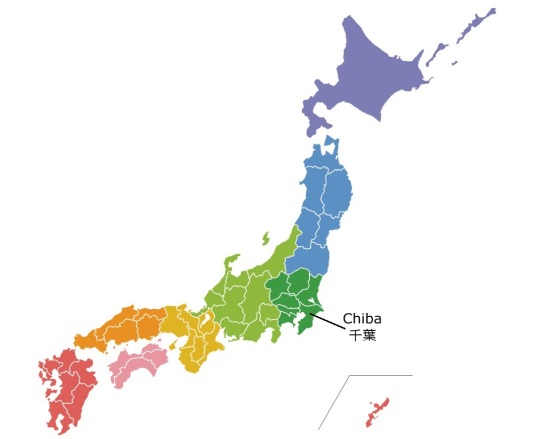
Chiba lies on the Bōsō Peninsula on the east coast of Tokyo Bay, about 20 miles (30 km) southeast of central Tokyo, and boasts many international facilities such as Narita International Airport, known as the gateway to Japan); Makuhari Messe, one of the most prominent convention centers in Asia; Kazusa DNA Research Institute, a world leader in cutting edge research; and Tokyo Disney Resort, with two theme parks that draw in 30 million patrons each year. It also boasts beaches for swimming, surfing, and diving and was the location for the first Olympic surfing games. Historically, Chiba was a castle town controlled by the Chiba family in the 12th–15th century, and during the Edo (Tokugawa) period (1603–1867) it served as a post-station town for several major roads. After the construction of a railway connecting it to Tokyo, the town began to grow in the second half of the 19th century.
Recommended Tourist Spot・おすすめ���光スポット Mt Nokogiri - 鋸山
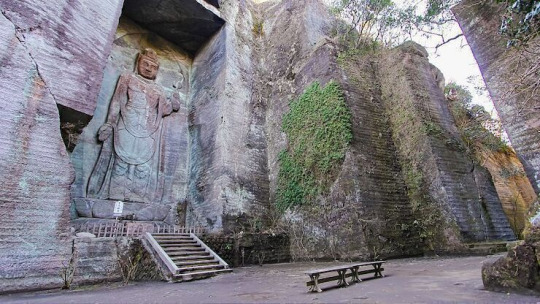
Mt. Nokogiri - Hyaku-Shaku Kannon carved into stone cliff
Mt. Nokogiri is named for the zigzag shape of a traditional handsaw that its topography resembles. Along with Mt. Kanozan and Mt. Kiyosumi, Mt. Nokogiri is one of Chiba's three most famous mountains. It stands at 330 meters high and features a grand lookout point as well as a temple complex containing one of Japan's largest Buddhas. The mountain is bare granite and has been a quarry since the Edo Period, providing stones for many of Tokyo's most iconic sites, such as Yasukuni Shrine and Waseda University. You can reach the top by an easy hike or via a ropeway to the top. Hell Lookout (地獄のぞき) is a lookout point at the top of the mountain that hangs over the edge of the cliff and offers a stunning view of Tokyo Bay, the Pacific Ocean, and the distant forests and hills of the Boso Peninsula, and on clear days, Mt. Fuji.
At the southern base of Mt. Nokogiri is Nihonji Temple (日本寺), an officially designated Important Cultural Property. There's a stairway leading from the top of the mountain down to the vast, picturesque Soto Zen Buddhist temple that dates back 1300 years and is still used to train young monks today. A giant daibutsu, or Buddha statue, is carved into the granite on the side of Mt. Nokogiri about midway up the mountain. It is 31 meters high and one of Japan's largest Buddhas, even larger than Kamakura's famous daibutsu at Kotokuin Temple. The statue was built to pray for world peace and most of the statue was carved over three years beginning in 1780.
In addition to the giant daibutsu, there are around 1500 small statues of various Buddhist deities around the temple grounds. Unfortunately, many of the smaller statues were beheaded during the anti-Buddhist movement that accompanied the Meiji Restoration, but there are ongoing efforts to repair them. This part of Nihonji was a spiritual sanctuary built over 21 years in the 18th century by craftsman Ono Kangoro and his students. Towards the top of the mountain stands a 30-meter tall Hyaku-Shaku Kannon, depicting the Buddhist Goddess of Mercy. Carved in 1966 into a stone cliff, it is dedicated to those who died in wars, of sickness or in accidents. The Kannon is also worshiped as a protector of transportation due to its protected location surrounded by rocks.
Regional Cuisine - 郷土料理
Sangayaki - さんが焼き

Sangayaki (source)
Namerou and sangayaki are well-known Chiba dishes, especially along the Bōsō Peninsula. Namerou (なめろう) is a dish usually made of minced horse mackerel and sardine mixed with miso, perilla leaves, and leek. When grilled and wrapped in perilla leaves, it is called sangayaki (さんが焼き). The name "namerou" may have come from the fact that namerou is so good that you want to lick your plate clean (nameru means to lick). The name "sangayaki" may be from the fact that the fishermen ate the dish along a river tributary, or sanga, and the word yaki means to grill (like yakisoba or yakitori). Namerou can be cooked in other ways, such as being shaped and grilled like a burger, or being coated in breadcrumbs and fried.
Chiba Dialect・Chiba no hougen・千葉の方言
Note: Chiba dialect is sometimes called Bōsō-ben (房総弁), after the peninsula. Chiba dialect is actually a family of three dialects: Bōshū-ben (房州弁), Tōsō-ben 東総弁, and Noda-ben (野田弁).
Bōshū-ben (房州弁)
1. おいねえ oinee not good
はしけえでおいねえや (hashikee de oinee ya)
Standard Japanese: かゆくていけないよ (kayukute ikenai yo)
English: This itches so badly
2. くわっせえ kuwassee please eat (command)
ばーさんほら、わーかでいーがらくわっせぇよ (baa-san hora, wa-ka de iigara kuwassei yo)
Standard Japanese: おばあさんほら、少しでいいから召し上がってよ (obaasan hora, sukoshi demo ii kara meshi agate yo)
English: Grandma, come on, please just eat a little bit
3. やんべえ yanbee health; condition (often used in a greeting)
いいやんべえだねえ (ii yanbee da nee)
Standard Japanese: こんにちは (konnichiwa)
English: Hello; Good day (lit. "you are in good health today")
Tōsō-ben 東総弁
1. あじょうだぁ ajyou daa how is it
あじょうだぁ? (ajyou daa?)
Standard Japanese: どうですか? (dou desu ka?)
English: How is it?
2. ねっけぇ nekkee warm
今日はずいぶんとねっけぇね (kyou wa zuibun to nekkee ne)
Standard Japanese: 今日はずいぶんと暖かいね (kyou wa zuibun to atatakai ne)
English: Today is fairly warm, isn't it?
3. わんらー wanraa you (informal, not very polite)
わんらーよー!んなことやってねーよ! (wanraa you! 'n na koto yatte nee yo!)
Standard Japanese: あなたねえ!そんな事しないでよ! (anata nee! sonna koto shinai de yo!)
English: Hey you! Stop doing that!
Noda-ben (野田弁)
1. こわい kowai difficult, taxing, bothersome
風邪ひいででまーだこわいだよなぁ (kaze hiide de maa-da kowai da yo naa)
Standard Japanese: 風邪を引いていてまだ身体がだるいんだよね (kaze wo hiite ite mada karada ga daruin da yo ne)
English: I have a cold and my body still feels listless
2. はらくち harakuchi full
はらくちだよなぁ (harakuchi da yo naa)
Standard Japanese: お腹いっぱいだよね (onaka ippai da yo ne)
English: I'm full
3. やっこら yakora soon
やっこらいくべ (yakora iku be)
Standard Japanese: そろそろいこうか (sorosoro ikou ka)
English: Shall we go soon?
#japanese prefectures#日本語#japanese#japanese language#japanese langblr#langblr#studyblr#都道府県#千葉県#chiba
34 notes
·
View notes
